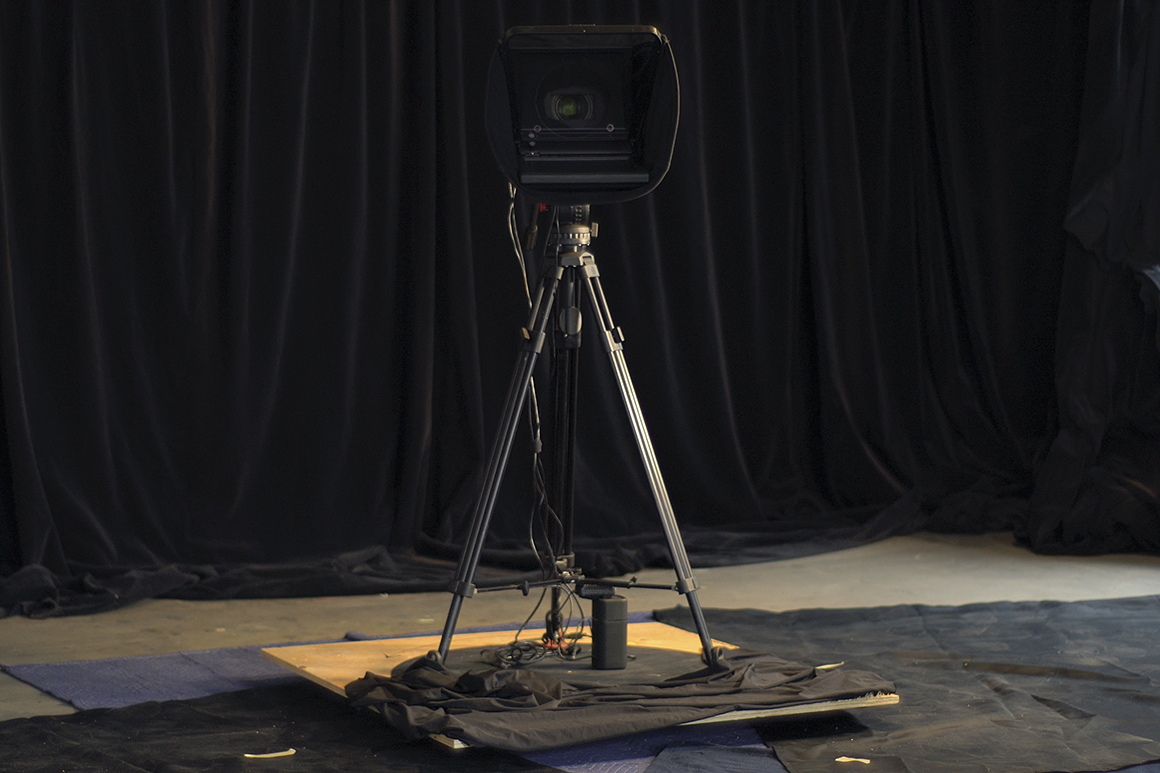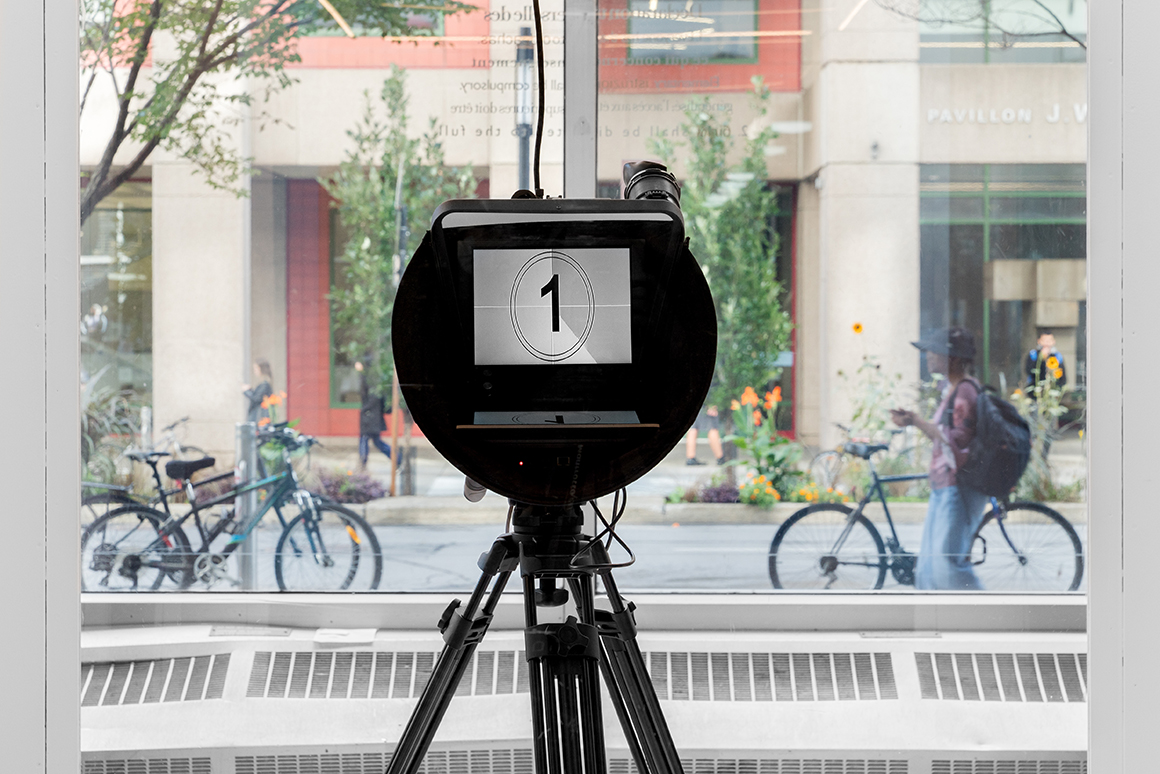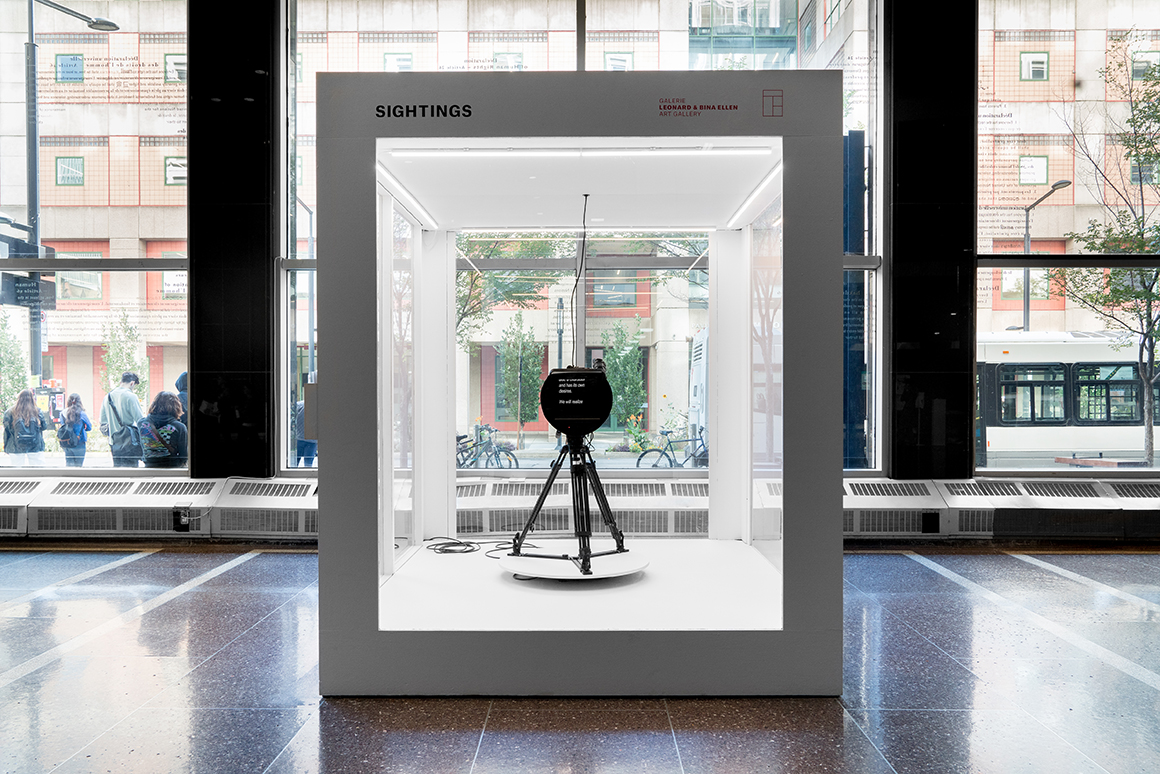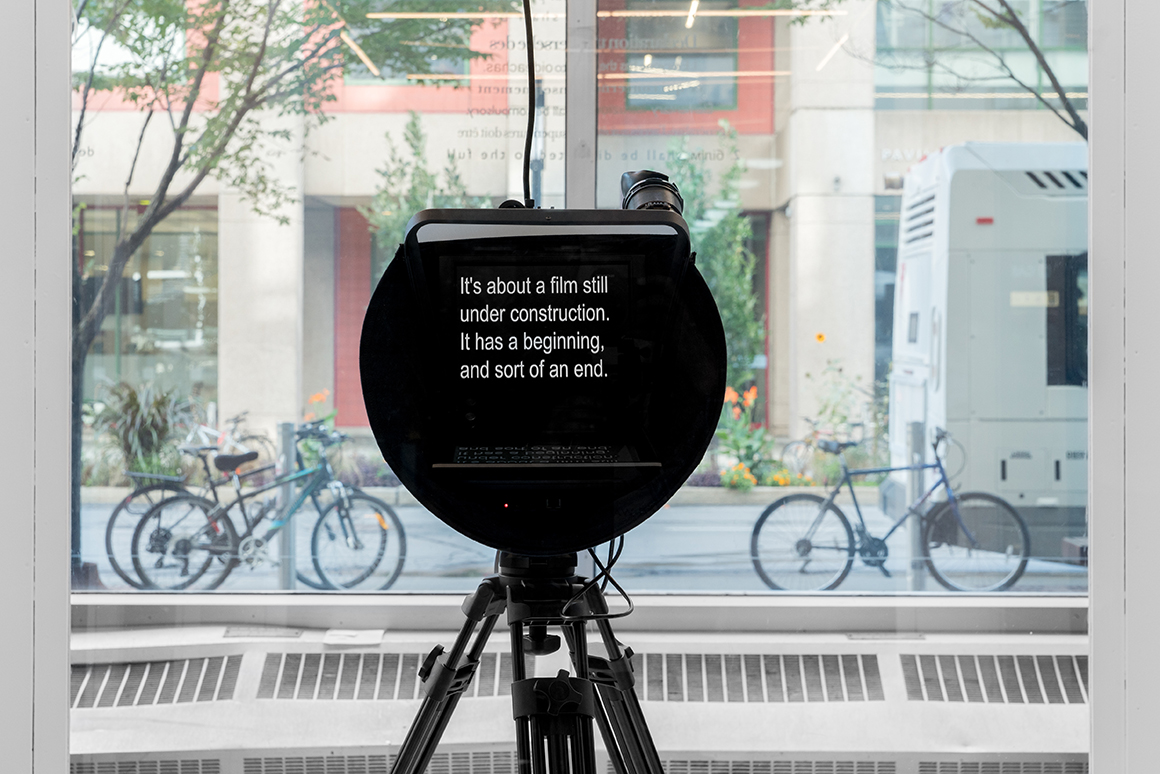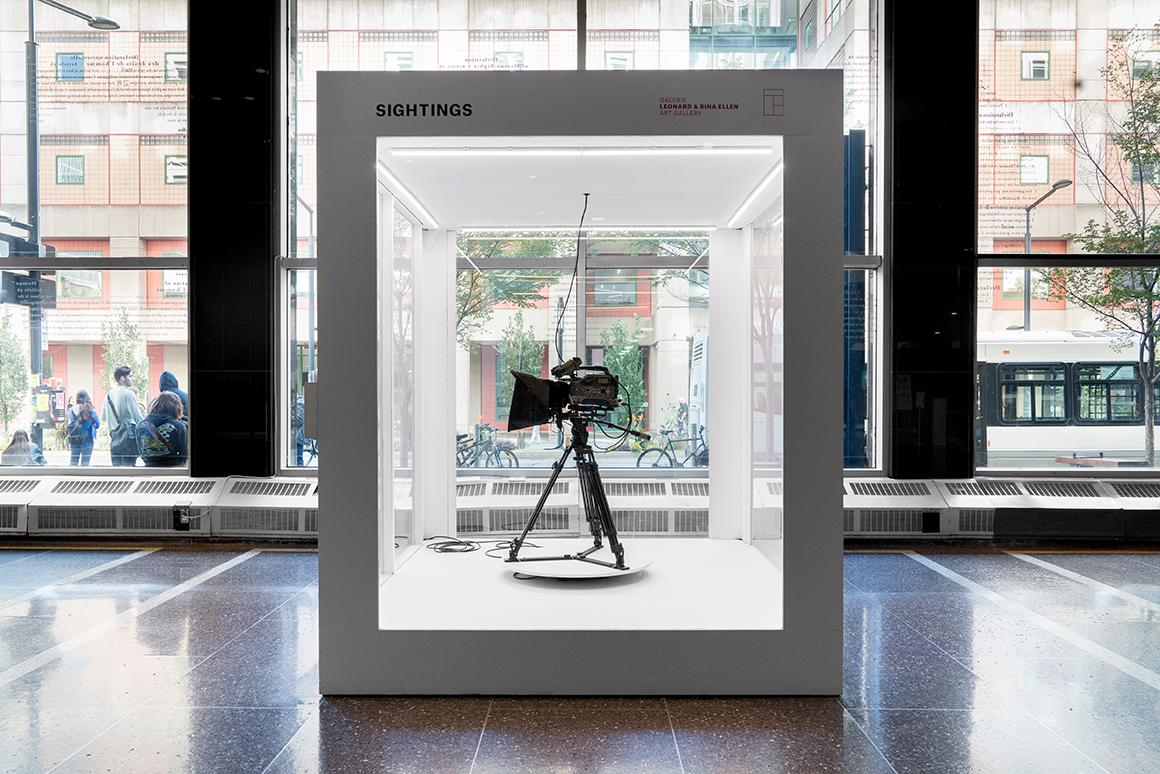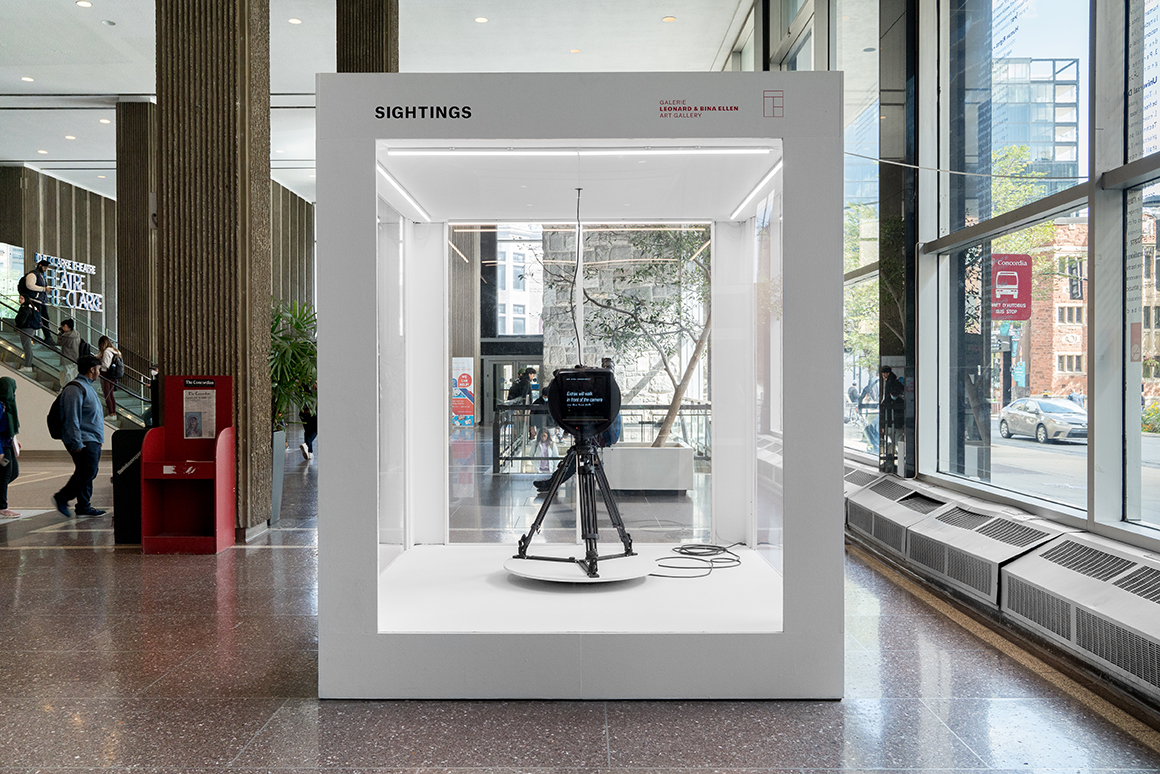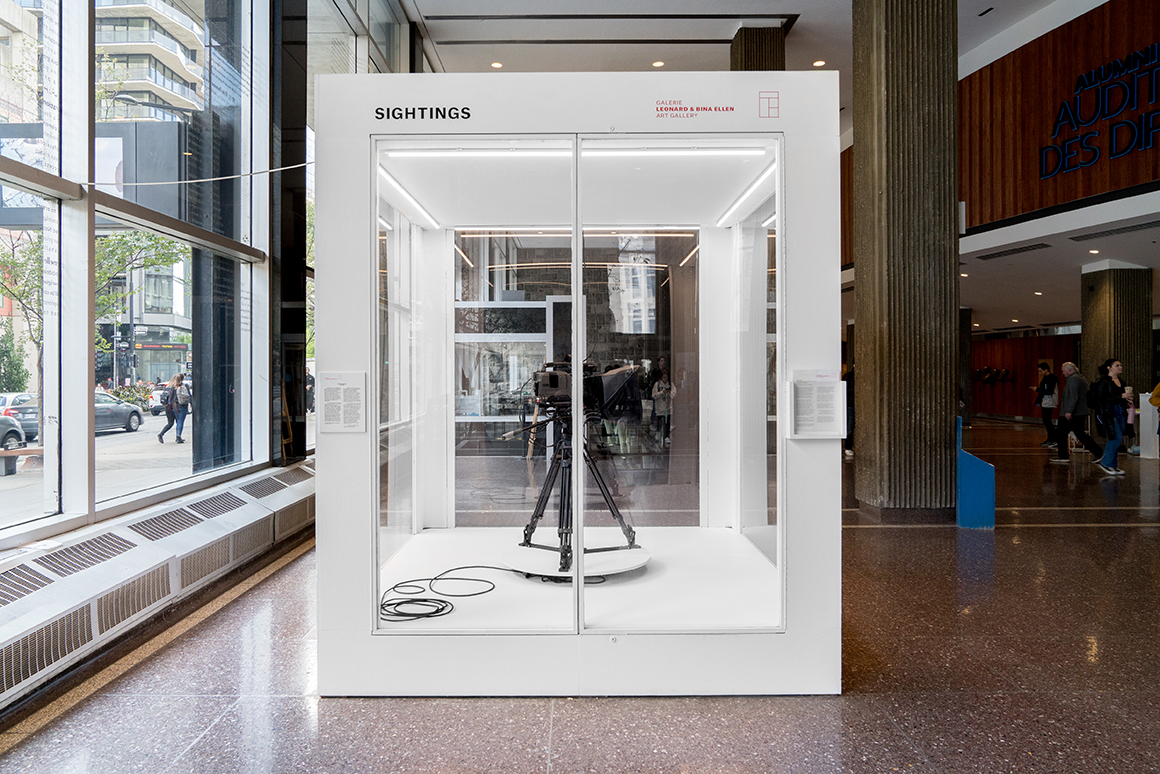SIGHTINGS 2022-2024
SEE FEVER
Launched in 2012 in celebration of the 50th anniversary of the Leonard & Bina Ellen Art Gallery’s Permanent Collection, the SIGHTINGS satellite exhibition program was conceived as an experimental platform to critically reflect upon the possibilities and limitations of the modernist “white cube.” As part of this program, artists and curators are invited to develop projects for a cubic display unit located in a public space at the university, with the aim of generating new strategies for art dissemination.
This fall, the Gallery launches a multi-year cycle focusing on the theme SEE FEVER. The expression refers to a fervent desire to “see everything,” the lure of strategies that aim to see “more” or “further,” and to contexts that widen our field of vision or destabilize our perceptual mechanisms. Reflecting this theme, the SIGHTINGS cube is envisaged as a raised observation platform whose four transparent walls provide a 360-degree view. Projects will examine the viewing subject’s perceptual and psychic experience when presented with a wide-angle perspective, the search for the panoramic view and the horizon, and the optical apparatuses and technologies that permit the augmentation, enhancement, and disorientation of vision’s spatial logic.
SIGHTINGS is located on the ground floor of the Hall Building: 1455, blvd. De Maisonneuve West and is accessible weekdays and weekends from 7 am to 11 pm. The program is developed by Julia Eilers Smith.
UNTITLED, LEONARD & BINA ELLEN ART GALLERY
Simon Belleau (b. 1986) is an artist and filmmaker based in Montreal. He completed in 2015 an MFA at the School of the Art Institute of Chicago, where he was the recipient of the Jacques and Natasha Gelman Fellowship. Belleau has participated in multiple exhibitions in Canada, the United States and Europe, notably at the Musée d’Art Contemporain in Montreal, the Fondazione Antonio Ratti in Italy, and the Sculpture Center in New York. Between 2019 and 2021, he was an Artist-in-Residence and Lecturer in the Concordia University Sculpture department, and since 2019 he is one of the artists in residence at the Fonderie Darling. Belleau was selected for the CALQ’s six-month residency at the Québec Studio in Rome in 2023.
As soon as J invited me to participate in the See Fever cycle of SIGHTINGS, I had a feeling that I wouldn’t be able to resolve the ambiguity surrounding that huge podium that sits in the lobby of the Henry F. Hall Building of Concordia University. I have to admit, from the outset, that I loathe works on plinths. It’s the plinths, more than the works placed on them, that bother me, but it’s also the combination of the two that I’ve always found problematic.
Of course, there are exceptions. I can think, for example, of Cy Twombly’s plaster sculptures on loan at the Art Institute of Chicago, which I saw again last spring. Seven sculptures placed on plinths (except for one whose base is a natural extension of the work) are set out in turn on a large white platform on the floor. A big skylight above the installation provides all the lighting needed. The light from the sky is reflected on the platform and illuminates the sculptures from below, giving the impression that the grouping isn’t touching the ground. The combination of these elements alleviates the heaviness that I usually associate with the presence of plinths in a space.
[HENRY F. HALL BUILDING. CORRIDOR. Interior. Day.
Woman. From the back. Very thin. Hunched over.
Carries two grocery bags in her right hand.]
It took me a few months to realize that I wasn’t asking the right questions about the SIGHTINGS cube, and that to better understand the “What is it?” of the object-site, I had first to set my sights on the “Where is it?” of the object-site.
By turning toward the “where” instead of the “what,” I realized that it’s difficult for the cube and what it contains to hold the sustained attention of passersby. The cube, which is already in itself a sculpture, is in fact situated in a non-site,[1] a passageway in which gazes are fleeting, through which people flee. It is there and nowhere at the same time.
Twombly’s sculptures in Chicago are simply called Untitled, followed by the name of the city where they were created (Untitled, New York; Untitled, Rome; Untitled, Bassano in Teverina; Untitled, Lexington, and so on).
[BOULEVARD DE MAISONNEUVE. BUS STOP. Exterior. Day.
A man puts his hand in the back pocket of his partner’s jeans
and keeps it there.]
I asked J if she had ever seen Twombly’s sculptures at the Art Institute. She said no, she had been in Chicago just once, on her way back from San Francisco by car, and she’d gone to the beach before getting back on the road.
I like to think that an artwork, beyond being defined by its form, can be defined by the place where it was conceived, like entries in a diary or notebook—in other words, envisaging the artwork as a personal archive of our movements in time. In this sense, and following Twombly’s logic, the installation Untitled, Leonard & Bina Ellen Art Gallery could also have been titled Untitled, Corridor in the Henry F. Hall Building of Concordia University, or Untitled, Lobby of the Henry F. Hall building, or Untitled, Montréal, or anything along those lines.
When I read Marc Augé’s Non-Places, in 2014, I was in fact living in Chicago and preparing to film my master’s degree project on the 108th—the top—floor of the Willis Tower during an episode of extreme fog. At the time, the Willis Tower (formerly the Sears Tower) was the tallest skyscraper on the continent, as the One World Trade Center in New York was still under construction.
[HENRY F. HALL BUILDING. ESCALATORS. Interior. Day.
An elderly person. On the phone. Mist on their glasses.]
In Chicago in late fall, it’s easy to predict the days when you won’t be able to see the tops of the skyscrapers and fog will cover the horizon. The heat of Lake Michigan rises into the air during the night and condenses in contact with the ambient cold air. Even on my first visit to the Willis Tower, the conditions for filming were perfect.
I let my camera flee and wander along the four glassed walls of the top floor of the Willis Tower, engulfed in the thick wall of fog. It’s curious sometimes to notice the absolute ordinariness of interiors once the vistas are withdrawn. The dull colour of the carpeting, the assortment of leather furniture and artificial plants. Then, the sudden realization that all this is arranged to accommodate visitors’ desire to look into the distance, and once this possibility is taken away, nothing remains but a banal, standardized environment, like a film set built to be seen and filmed only from one side.
The final edit of my master’s degree project was never completed; no script was written. The film was a failure even before it was shot. My only intention at the time was to reach the highest place on the continent in order to aim my camera at something that can’t be seen. Although I got there, there was never a film. I remember telling myself, in the elevator that took me back down to the ground floor, that this experience would have been more interesting if it were recounted by a voice, rather than being filmed. In films, the voice is a good compromise when it’s impossible to see (like the voices that go searching for Anna after she disappears on the island in Michelangelo Antonioni’s film L’avventura).
It’s strange today to think about how the two projects relate to each other: the making of a film without words at the top of a skyscraper in Chicago, then the rough draft, in a panoramic glass box, of a film without images.
S
[1] This concept is proposed by the anthropologist Marc Augé in Non-Places: Introduction to an Anthropology of Supermodernity(London: Verso, 1995).
Simon Belleau (b. 1986) is an artist and filmmaker based in Montreal. He completed in 2015 an MFA at the School of the Art Institute of Chicago, where he was the recipient of the Jacques and Natasha Gelman Fellowship. Belleau has participated in multiple exhibitions in Canada, the United States and Europe, notably at the Musée d’Art Contemporain in Montreal, the Fondazione Antonio Ratti in Italy, and the Sculpture Center in New York. Between 2019 and 2021, he was an Artist-in-Residence and Lecturer in the Concordia University Sculpture department, and since 2019 he is one of the artists in residence at the Fonderie Darling. Belleau was selected for the CALQ’s six-month residency at the Québec Studio in Rome in 2023.
The artist wishes to thank Julia Eilers Smith, Michèle Thériault, Samuel Garrigo Meza, Bernard Schütze, Roby Provost Blanchard, Marie-Eve Dubé and Prompter MTL inc., Fonderie Darling and JLG.







